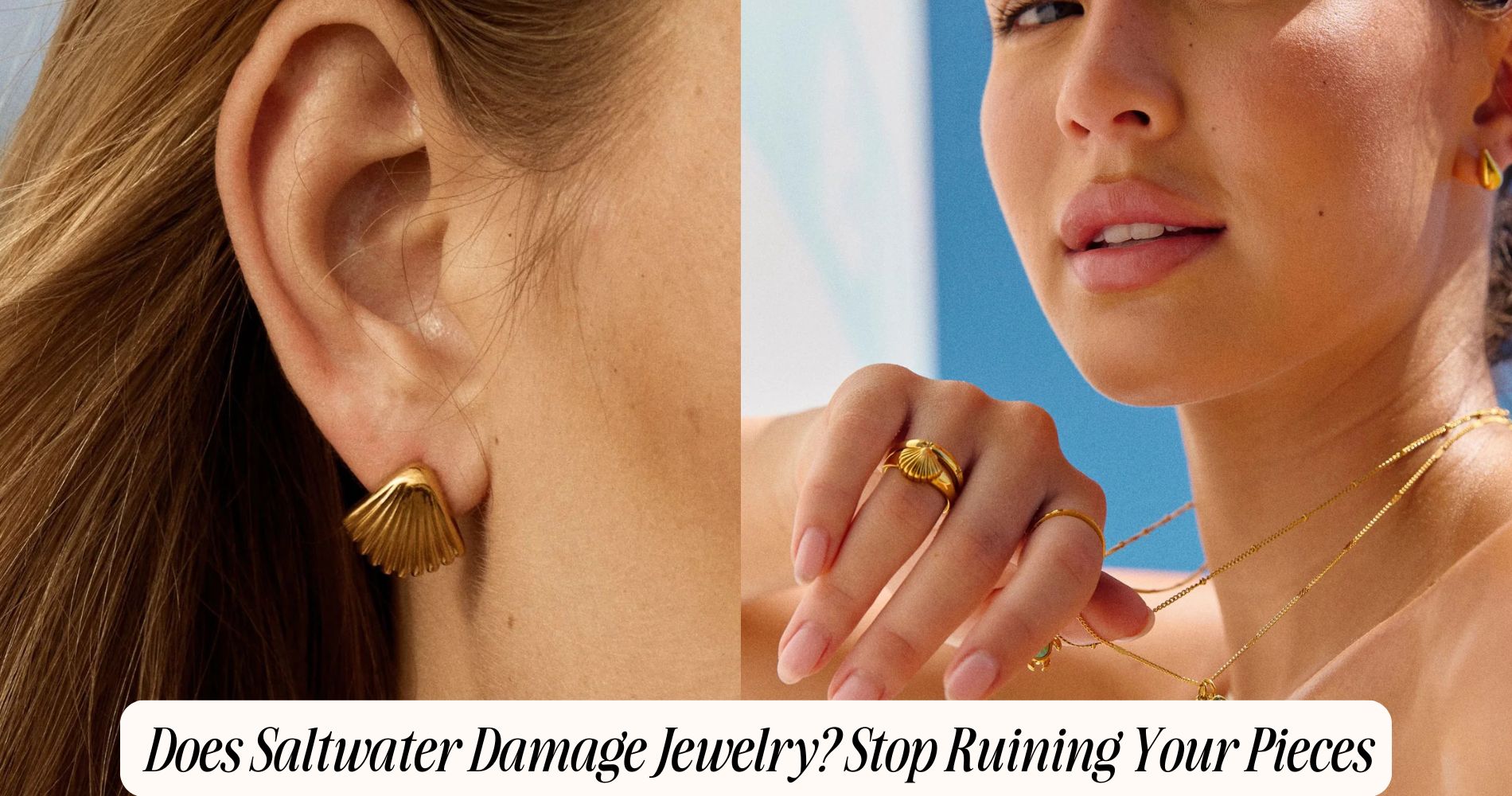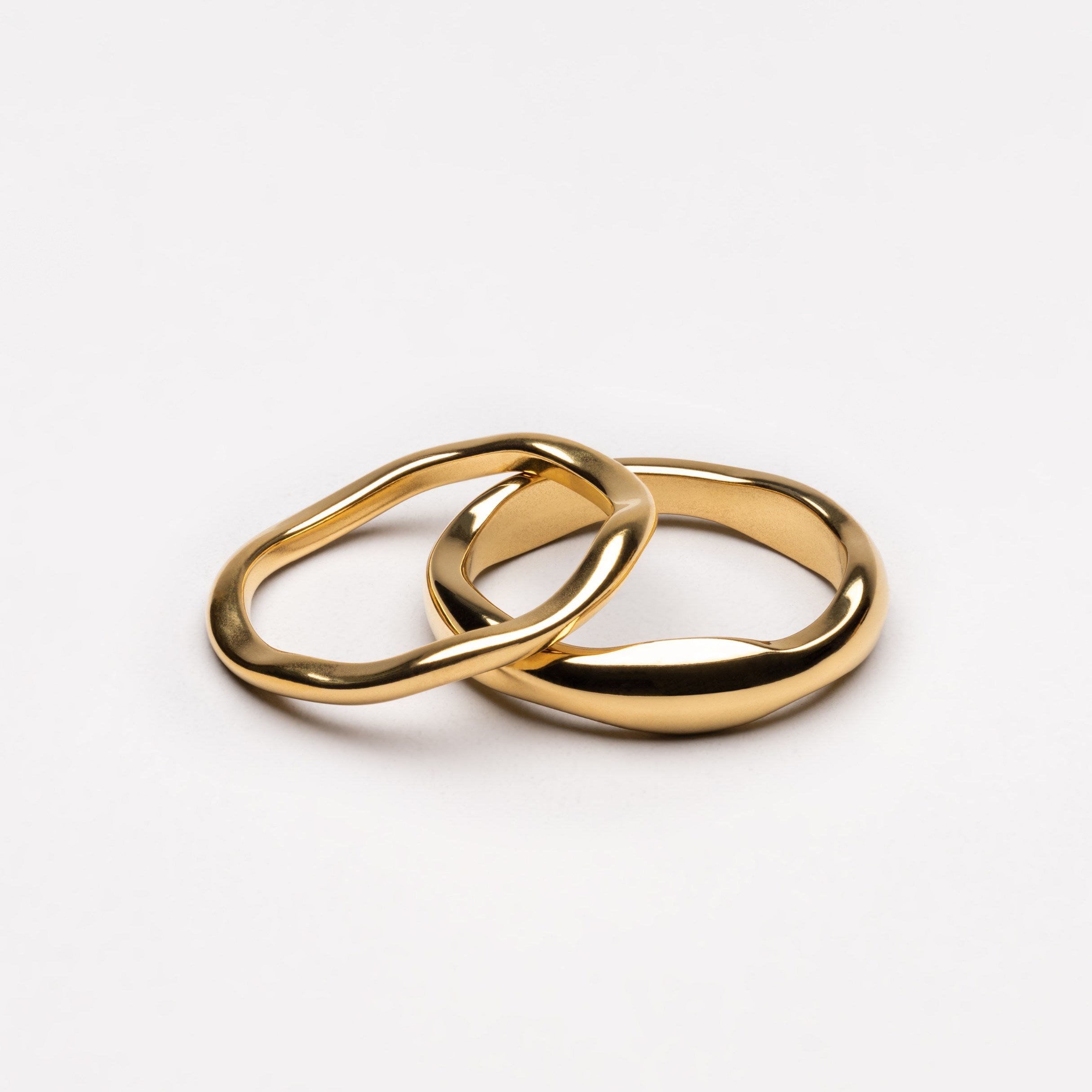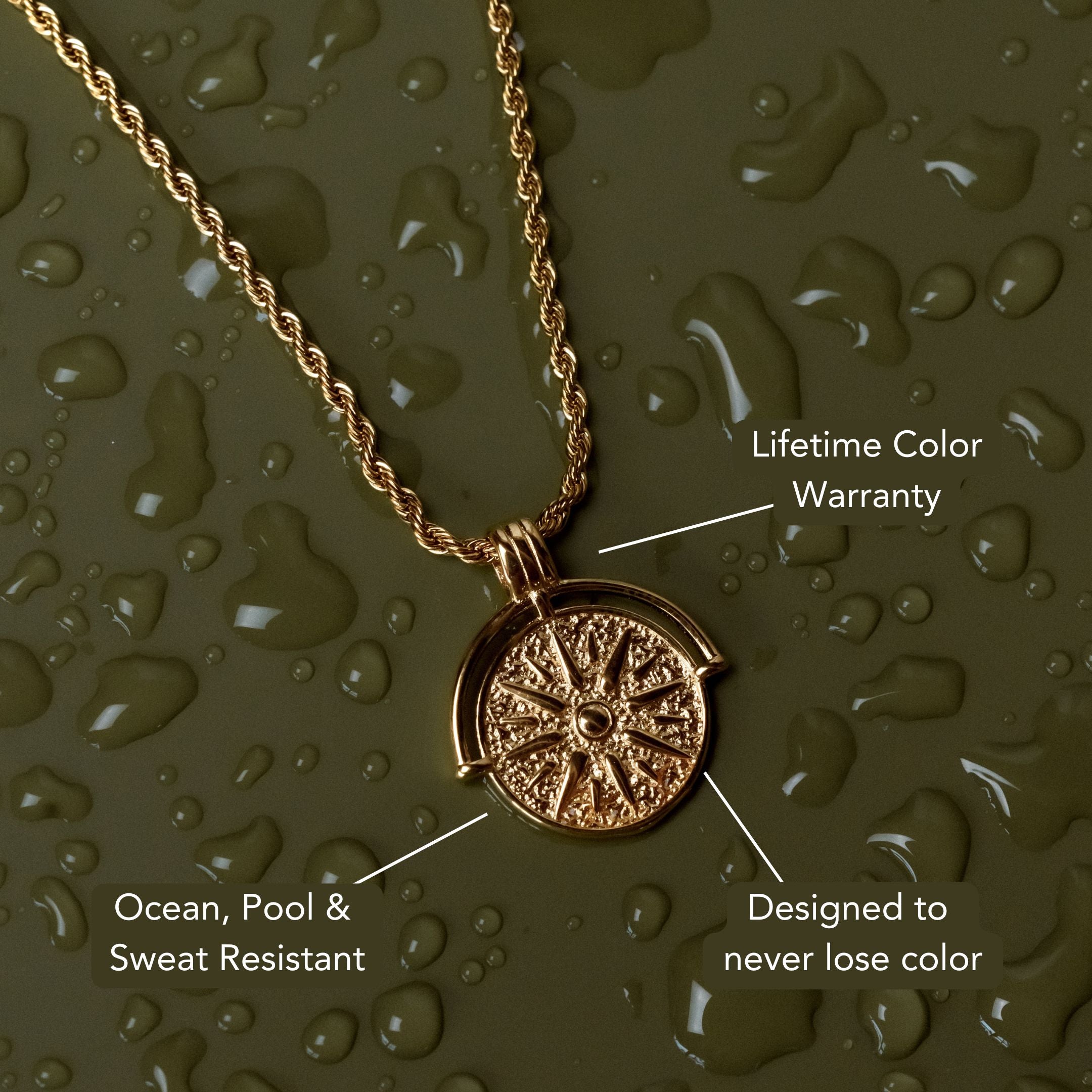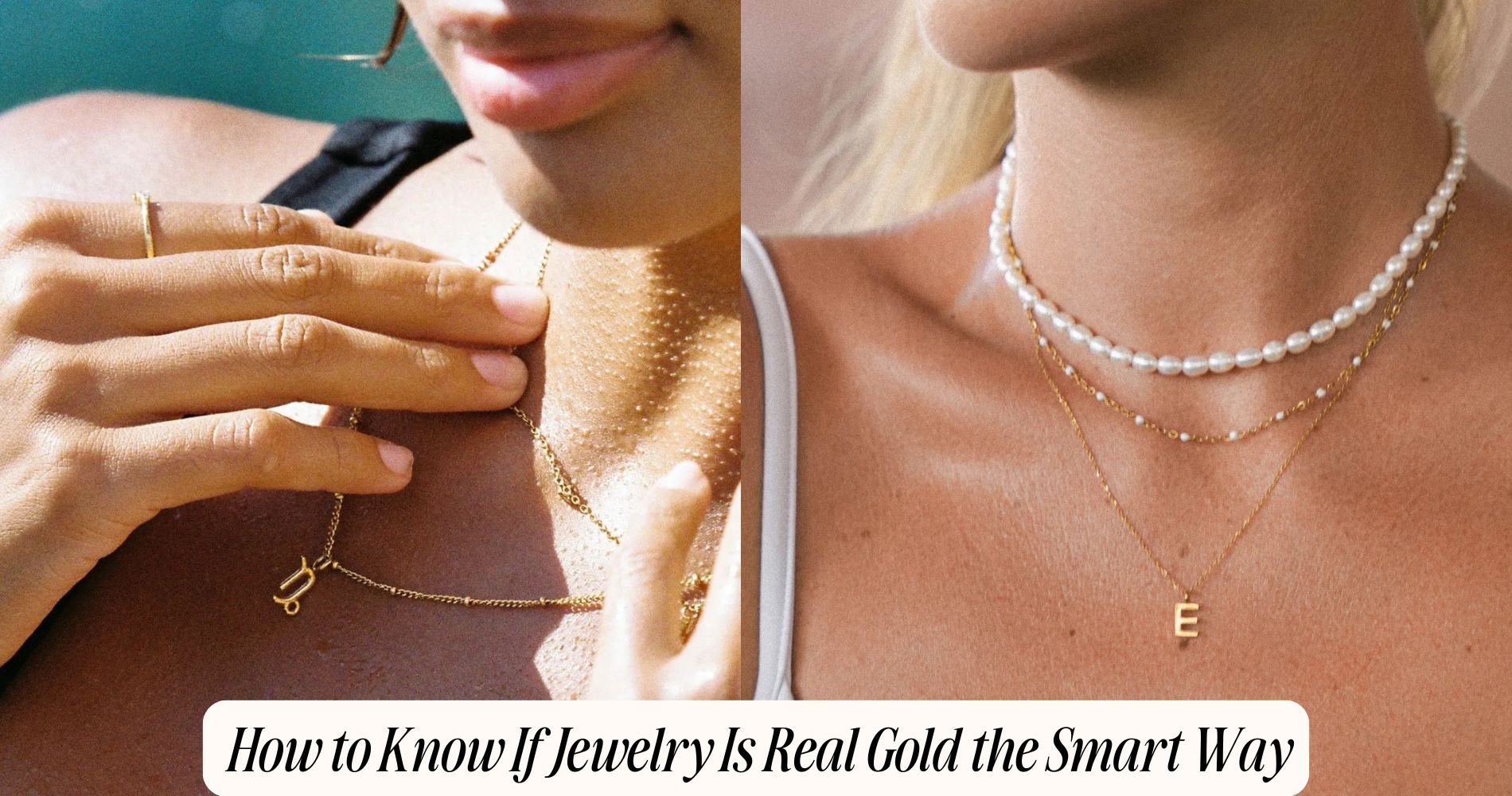
Does Saltwater Damage Jewelry? Stop Ruining Your Pieces
Does saltwater damage jewelry? Absolutely—especially when it comes to silver, lower karat gold, and plated pieces. Saltwater accelerates tarnish, corrosion, and can weaken delicate finishes. Even gemstones and pearls aren't safe; they can lose their shine or become etched from salty exposure. That’s why it’s essential to remove your jewelry before swimming in the ocean, and rinse it with fresh water if it gets wet. Dry it thoroughly to avoid lingering chemical damage. Love styling jewelry at the beach? Explore our gold beachy jewelry collection, designed to shine with coastal flair. Read on for simple tips to keep your favorite pieces brilliant and strong.
Understanding the Effects of Saltwater on Jewelry
When you expose jewelry to saltwater, its high salinity and mineral content can accelerate corrosion, tarnishing, and structural degradation—especially in metals like sterling silver and lower karat gold.
As saltwater dries, it leaves salt deposits on your jewelry’s surface. These deposits trap moisture, promoting saltwater corrosion by facilitating electrochemical reactions that attack the metal’s structure. Even small amounts of salt can penetrate crevices, worsening damage over time.
Gemstones aren’t immune; salt deposits may dull their luster or etch softer stones. To minimize harm, always rinse jewelry with fresh water after saltwater exposure. Pat dry thoroughly to remove residual moisture and salt.
Store pieces in a cool, dry place to avoid ongoing corrosion. Proper care helps maintain your jewelry’s integrity and brilliance.
How Saltwater Reacts With Different Metals
Different metals react to saltwater exposure in distinct ways, with their composition and purity levels playing a significant role in their vulnerability.
When you wear gold jewelry, higher karat gold offers better corrosion resistance due to its purity, while lower karat pieces, often mixed with copper or silver, are more susceptible to tarnishing and degradation.
Sterling silver, a metal alloy containing 92.5% silver and 7.5% other metals (commonly copper), reacts quickly with saltwater, leading to rapid tarnish and pitting.
Stainless steel jewelry boasts excellent corrosion resistance thanks to its chromium content, making it more suitable for ocean environments. However, even stainless steel can eventually show signs of surface corrosion if not rinsed and dried promptly after saltwater exposure.
Always clean and dry your jewelry thoroughly.
The Vulnerability of Gemstones in Ocean Water
Although gemstones may appear robust, many are surprisingly susceptible to damage from saltwater exposure. You’ll find that porous stones like opals, turquoise, and emeralds readily absorb salty moisture, which can cause discoloration, surface etching, or even structural weakening.
Coral fragility is a major concern—coral is organic and calcareous, so ocean water can erode its surface, dull its luster, and make it brittle.
Pearl sensitivity is likewise critical; pearls are made of calcium carbonate and layers can dissolve or become pitted with prolonged saltwater contact.
Even harder stones such as amethyst or sapphire may lose polish or accumulate salt residues in settings.
To protect your jewelry, always remove gemstone pieces before swimming in the ocean and rinse them promptly if accidental exposure occurs.
Gold, Silver, and Platinum: Which Holds Up Best?
While saltwater affects all metals to some extent, gold, silver, and platinum respond quite differently to ocean exposure.
Pure gold (24k) is the most stable; it resists corrosion from saltwater minerals and marine life. However, most gold jewelry contains alloys, and lower karat gold (such as 14k or 10k) is more vulnerable to tarnishing and pitting in salty environments.
Silver is especially reactive—saltwater accelerates tarnish and can cause surface blackening due to silver chloride formation.
Platinum stands up best; it’s highly resistant to corrosion, even when exposed to abrasive saltwater minerals and organic matter from marine life.
To maintain luster, rinse your pieces with fresh water after beach outings and dry thoroughly to prevent mineral deposits and surface dulling.
How Saltwater Impacts Plated and Costume Jewelry
Beyond solid precious metals, plated and costume jewelry face even greater risks in saltwater. The thin metal layers on plated pieces—whether gold, silver, or rhodium—are especially vulnerable. Saltwater quickly eats away at these coatings, exposing the base metal underneath.
Costume jewelry, often made from brass, copper, or nickel alloys, can corrode or discolor even faster. You shouldn’t rely on saltwater cleaning for these items; it accelerates fading, pitting, and structural weakening.
For proper jewelry maintenance, always remove plated or costume pieces before swimming or beach outings. After accidental exposure, rinse jewelry thoroughly with fresh water and dry completely to minimize damage.
Store them in a dry environment, preferably in soft pouches, to further protect delicate finishes from lingering moisture and salt residues.
The Science Behind Corrosion and Tarnishing
When saltwater comes into contact with jewelry, it initiates specific chemical reactions that accelerate both corrosion and tarnishing. The high concentration of chloride ions in saltwater aggressively attacks metal surfaces, especially in silver, copper, and low-karat gold alloys. These ions disrupt the protective oxide layers, exposing fresh metal and triggering the oxidation process.
As oxygen interacts with these exposed surfaces, you’ll notice tarnishing—a dull, discolored film—forming much faster than in freshwater or air.
Even stainless steel and gold-plated pieces aren’t immune, as microscopic breaches in protective coatings allow saltwater to penetrate and start these reactions underneath. To maintain your jewelry’s integrity, you need to minimize exposure to saltwater.
Act quickly to rinse and dry pieces if they do get wet, preventing further chemical reactions.
Steps to Take If Your Jewelry Gets Wet at the Beach
If your jewelry gets wet at the beach, act immediately to prevent saltwater-induced corrosion and tarnishing. First, rinse your beach jewelry thoroughly with fresh water to remove salt deposits and prevent chloride ions from accelerating metal oxidation.
Use a soft, lint-free cloth to pat pieces dry; avoid rubbing, which can scratch softer metals like gold or silver. For intricate designs or gemstone settings, use a soft brush to dislodge sand and salt from crevices.
Inspect clasps and prongs for any saltwater effects, such as discoloration or weakness. If you notice damage, don’t delay professional cleaning or repair.
Store your jewelry in a dry, airtight container once clean. Prompt action minimizes corrosion and helps preserve the integrity and brilliance of your favorite pieces.
Preventative Measures for Jewelry Safety by the Sea
Although a day at the shore is enticing, you should take proactive steps to safeguard jewelry from saltwater exposure. For ideal beach safety, remove all jewelry before entering the water, especially pieces made of sterling silver, gold-plated metals, and those containing porous gemstones like opals or pearls. Saltwater rapidly corrodes metals and weakens gemstone settings, increasing the risk of loss or irreversible damage.
Use dedicated jewelry storage, such as a lined travel case or a soft pouch, to prevent scratches and minimize humidity. Store your items in a cool, shaded place—never leave them in direct sunlight or on hot sand, which can accelerate tarnishing and warping.
Best Cleaning Practices After Saltwater Exposure
Even with careful prevention, jewelry may still come into contact with saltwater, requiring immediate and proper cleaning to halt corrosive effects.
First, rinse your pieces thoroughly under lukewarm, fresh water to remove salt deposits.
For gold, platinum, or sterling silver, use a mild soap as your cleaning agent—avoid harsh chemicals that can strip finishes or damage gemstones.
Soft-bristled brushes allow you to reach crevices without scratching metal or stones.
Dry completely with a lint-free cloth to prevent moisture retention, which accelerates tarnishing.
Before storing, inspect your jewelry for lingering residue or damage.
Choose storage solutions like anti-tarnish pouches or lined boxes to reduce exposure to air and humidity.
Prompt, careful cleaning and correct storage will preserve your jewelry’s integrity and appearance.
Frequently Asked Questions
Can Saltwater Affect Jewelry With Enamel or Painted Details?
Saltwater can cause enamel deterioration and painted finish damage on your jewelry. You should avoid exposing these pieces to saltwater, as it accelerates fading, chipping, and corrosion. Rinse thoroughly with fresh water if accidental contact occurs.
Does Exposure to Saltwater Impact Antique or Heirloom Jewelry Differently?
You should know that exposure to saltwater accelerates corrosion and tarnish in antique or heirloom jewelry, especially pieces with delicate alloys or settings. For ideal antique preservation and heirloom care, always remove such jewelry before entering saltwater environments.
Will Saltwater Harm Jewelry That Contains Glue-Set Stones or Pearls?
If you expose glue-set stones or pearls to saltwater, you risk saltwater corrosion weakening adhesives and damaging organic materials. This reduces jewelry durability. Always remove these pieces before swimming and rinse immediately if accidental exposure occurs.
Can Saltwater Damage Jewelry Stored Nearby, Even if Not Worn?
You shouldn't store jewelry near saltwater, since airborne salt particles can cause saltwater corrosion over time. Always use airtight containers and silica gel packs as storage precautions to protect metals like sterling silver and certain gold alloys.
Conclusion
To protect your jewelry’s integrity, always remove pieces before entering saltwater. Salt accelerates corrosion in silver, weakens gold alloys, and can loosen gemstone settings. Even platinum isn’t immune to surface dulling. If your jewelry gets wet, rinse thoroughly with fresh water and dry with a soft cloth. Avoid exposing plated and costume jewelry, as their finishes degrade quickly. With proper precautions and prompt cleaning, you’ll preserve both the brilliance and longevity of your cherished pieces.
























Leave a comment
This site is protected by hCaptcha and the hCaptcha Privacy Policy and Terms of Service apply.